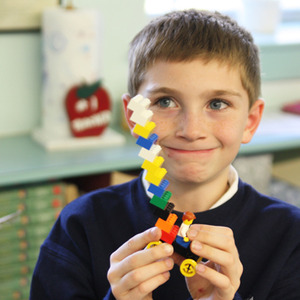STEM on a Shoestring: A Teacher’s Perspective
By Mary Jo Broderick
02-20-2015
Lessons learned from starting an after-school STEM club at a small Catholic school
This is the third in a multi-part series about how a neighborhood Catholic school in Baltimore City started an after-school STEM Club on a shoestring budget.
 Forget about fancy facilities or a well-endowed budget. A successful STEM club needs only dedicated teachers, volunteers, and students.
Forget about fancy facilities or a well-endowed budget. A successful STEM club needs only dedicated teachers, volunteers, and students.
As a small, K-8 Catholic school in the northeast corner of Baltimore City, St. Francis of Assisi School began a STEM Club on a shoestring budget two years ago. Under the direction and encouragement of Dr. Sandy Young, a parent volunteer and materials engineer, the number of students participating in the Club has more than doubled since our first year.
As a middle school teacher and one of the coordinators of STEM at our school, here are a few highlights of things I’ve observed about our STEM Club:
- S: Students grow the most when they’re invited to discover how they learn best. It’s fun to see the students working together in a myriad of ways – generating ideas and solutions, taking on leadership roles within their groups, or simply encouraging one another to succeed. One student might garner enthusiasm from the littlest successes and discoveries, while another might enjoy more grandiose competitions. I’ve found this to be especially true of the Lego League competitions for the younger students in grades 1-3 (JrFLL) and the older students in grades 4-8 (FLL).
- T: Topics that are outside of the traditional curriculum can be examined in the STEM Club. For example, programming. Our older students have ventured into the world of programming through First Lego League Competitions and Robotics. It’s exciting to see how some of the students are naturals at programming their robots to complete certain tasks on a set field. They also quickly learn that not everything works successfully the first time, and they need to test and retest their ideas until the desired results are achieved. In this way, students that might not excel in the classroom get a chance to really shine and take on leadership roles in the context of the STEM Club.
- E: Excitement generated by the STEM Club spills over into the classroom. One of the tools we’ve used in our STEM Club is a 3D printer. A few of our students participated in a 3D printing workshop held here at the school, made possible in part by a grant from the Knott Foundation, and their excitement spilled over into the classroom where they considered all the possibilities of how 3D printers can used for various projects.
- M: More and more students will learn about career opportunities in STEM. National Chemistry Week is celebrated in our STEM program to make students more aware of the importance of chemistry in our everyday lives. National Engineers Week is also part of our after-school topics, making students aware of what engineers do and how they make a difference in our world. By building these national movements into our STEM Club, our students have participated in chemistry and engineering activities, such as building circuits, that have helped them realize what chemists and engineers do in real life.
Starting and running an after-school STEM Club requires a commitment of all those involved – teachers, parents, students, and our principal. Good ideas, planning, and flexibility are key ingredients for success, and there will never be enough time and energy to accomplish everything (especially at the end of a school day!). The rewards, however, are great. Our students are becoming great “inquirers” and “problem-solvers,” and they are experiencing the spirit and fun of learning, teamwork, self-motivation, and competition.
Mary Jo Broderick is a middle school science teacher at St. Francis of Assisi School, a K-8 Catholic school in northeast Baltimore.
